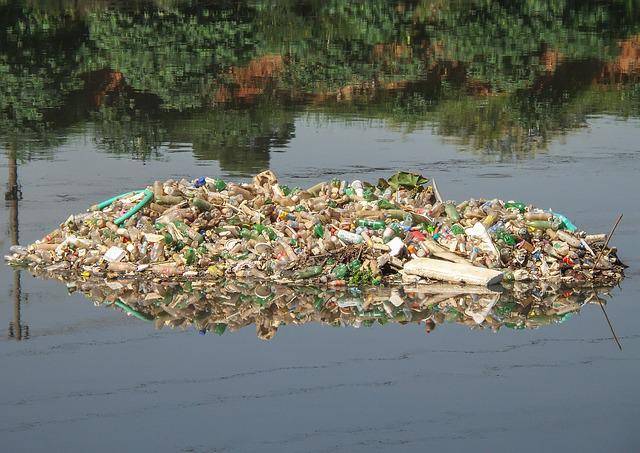
COMPETITIVE EXAM MCQs SERIES of ENVIRONMENTAL SCIENCE for UGC-NET/JRF, SLET, ARS, GATE, and other entrance tests – Environmental Pollution and Control – Water Pollution and Control.
Syllabus Outline
- Concept and types of water pollution.
- Water pollution sources and impacts on human health and the environment.
- Aquatic ecosystems and the major pollutants affecting their functioning.
- Water quality parameters, monitoring and assessment techniques.
- Water pollution control and management strategies (e.g. pollution prevention, wastewater treatment, and regulatory frameworks).
This quiz contains the concept-based most frequently asked 25 MCQs of “Environmental Pollution and Control – Water Pollution and Control“. Each question has a single correct/most appropriate answer.
*****
1. An object gets floated in the wastewater and the same object gets sinks in the drinking water because:
a) Wastewater has a lesser density than drinking water
b) Wastewater has a greater density than drinking water
c) Wastewater exerts less upthrust on the object than drinking water
d) Wastewater is more contaminated than drinking water
2. Temporary hardness of water is caused by the presence of
a) chlorides of calcium and magnesium
b) sulfates of calcium and magnesium
c) carbonates of sodium and potassium
d) bicarbonates of calcium and magnesium
3. Coliform bacteria in water is an indication of the presence of:
a) Radioactive wastes
b) Excess fertilizer
c) Decaying animals and plants
d) Human feces
4. DO levels in lotic water do not directly vary:
a) Seasonally
b) Diurnally
c) Inversely with water temperature and altitude
d) Inversely with degree of Hardness
5. Which of the following statements is false?
a) Transparency of water is important for photosynthesis
b) Density of pure water depends on temperature, salinity, and pressure
c) For seawater, the freezing point decreases with increasing salinity
d) Water has very high compressibility due to intermolecular hydrogen bonding
6. Which substance is formed when temporary hard water is boiled?
a) Calcium bicarbonate
b) Calcium sulfate
c) Hydrogen chloride
d) Carbon dioxide
7. Select the incorrect statement from the following option.
a) Water which does not form lather with soap and forms white scum is called hard water
b) Due to the presence of dissolved hardness-producing salts, the boiling point of water is depressed
c) Hard water contains dissolved calcium and magnesium salts in it
d) In hard water, the cleansing quality of soap is depressed
8. Which one of the following statements is incorrect?
a) The COD test is not suitable for toxic waste and is difficult to perform for heavily polluted water
b) In COD estimation, the chloride interference is eliminated by mercury sulfate.
c) Silver sulphate acts as a catalyst to stimulate the oxidation of straight-chain aliphatic and aromatic compounds in COD estimation.
d) COD test has less relationship to natural processes.
9. What is the primary purpose of BOD testing in water analysis?
a) Measuring oxygen concentration in water
b) Identifying microbial contaminants
c) Assessing organic pollution levels
d) Estimating total dissolved solids
10. What is the primary source of nitrate and nitrite ions in water bodies?
a) Industrial runoff
b) Agricultural fertilizers
c) Atmospheric deposition
d) Domestic sewage
11. The primary source of mercury pollution in aquatic environments is:
a) Industrial discharge
b) Agricultural runoff
c) Coal combustion
d) Urban stormwater runoff
12. The main method for controlling nutrient pollution in freshwater ecosystems is through the implementation of:
a) Primary treatment systems
b) Chemical precipitation
c) Biological nutrient removal
d) Activated carbon filtration
13. Acid mine drainage is primarily associated with the release of:
a) Organic pollutants
b) Heavy metals and sulfides
c) Nitrogen and phosphorus
d) Pathogens
14. The most effective method for removing suspended solids from wastewater is:
a) Filtration
b) Coagulation and flocculation
c) Sedimentation
d) Adsorption
15. The primary purpose of constructing constructed wetlands in water pollution control is:
a) Nutrient removal
b) Sedimentation
c) Disinfection
d) Oxygenation
16. The process of biomagnification refers to:
a) Accumulation of pollutants in aquatic sediments
b) Accumulation of pollutants in the tissues of organisms at higher trophic levels
c) Rapid growth of algal populations in water bodies
d) Formation of harmful algal blooms
17. The primary causes of ocean dead zones are:
a) Thermal pollution
b) Nutrient pollution
c) Oil spills
d) Heavy metal contamination
18. The process of ozonation in water treatment is primarily used for:
a) Disinfection
b) Removing suspended solids
c) Removing heavy metals
d) Neutralizing acidic pH
19. The phenomenon of ocean acidification is primarily driven by the absorption of:
a) Nitrogen oxides
b) Carbon dioxide
c) Sulfur dioxide
d) Methane
20. The process of denitrification in water bodies involves the conversion of nitrates to:
a) Nitrogen gas
b) Ammonia
c) Nitrous oxide
d) Nitrite
21. The main purpose of using coagulants in water treatment is to:
a) Disinfect water
b) Remove suspended solids
c) Adjust pH
d) Control algae growth
22. The primary mechanism through which thermal pollution impacts aquatic ecosystems is by:
a) Reducing dissolved oxygen levels
b) Reducing nutrient concentrations
c) Accelerating eutrophication
d) Increasing hardness level
23. The process of reverse osmosis in water treatment involves the:
a) Removal of suspended solids by pressure filtration
b) Separation of dissolved ions using a semi-permeable membrane
c) Chemical oxidation of pollutants
d) Biological degradation of organic matter
24. Assertion (A): Microplastics in marine ecosystems significantly threaten aquatic biodiversity.
Reasoning (R): Microplastics can be ingested by marine organisms, leading to physical harm, bioaccumulation of toxins, and disruption of ecological processes.
a) Both the A and R are correct, and the R explains the A.
b) Both the A and R are correct, but the R does not explain the A.
c) The A is correct, but the R is incorrect.
d) The A is incorrect, but the R is correct.
25. Assertion (A): The construction of wastewater treatment plants can effectively mitigate nutrient pollution in receiving water bodies.
Reasoning (R): WWTPs employ biological nutrient removal processes to capture and remove excess nitrogen and phosphorus from wastewater effluents before discharge.
a) Both the A and R are correct, and the R explains the A.
b) Both the A and R are correct, but the R does not explain the A.
c) The A is correct, but the R is incorrect.
d) The A is incorrect, but the R is correct.
*****
Previous: Noise Pollution and Control
Next: Measurement of Water Quality Parameters
References
- Metcalf & Eddy, Inc., Tchobanoglous, George, Burton, Franklin L., and Stensel, H. David (2013) Wastewater Engineering: Treatment and Resource Recovery, McGraw-Hill Education, 5th edition.
- Sharma, S. K. (2019) Water Pollution and Its Management, Khanna Publishers, 1st edition.
- Rao, N. N. (2006) Water Pollution, Tata McGraw-Hill Education, 2nd edition.

